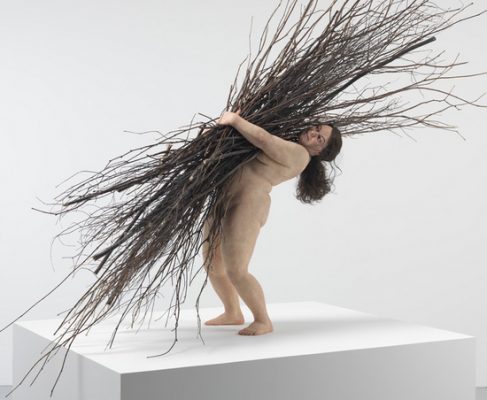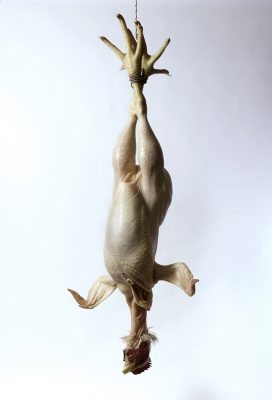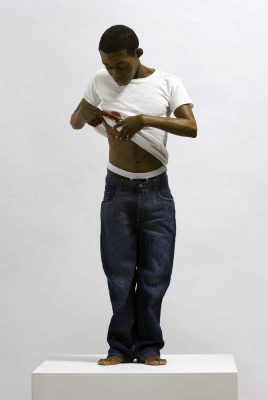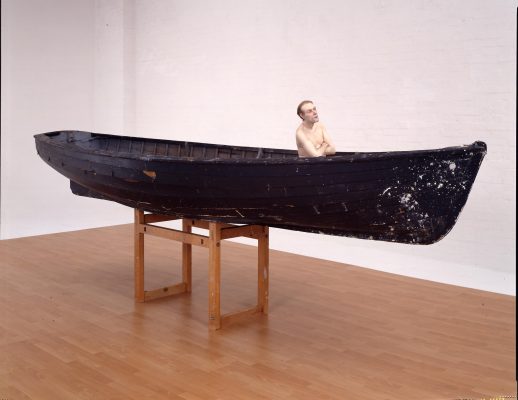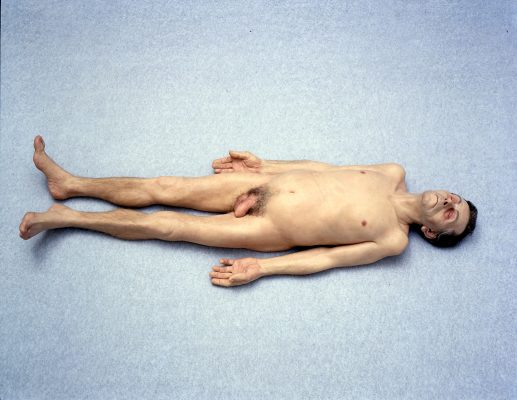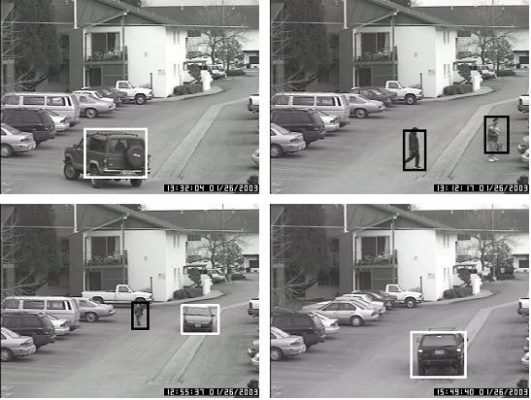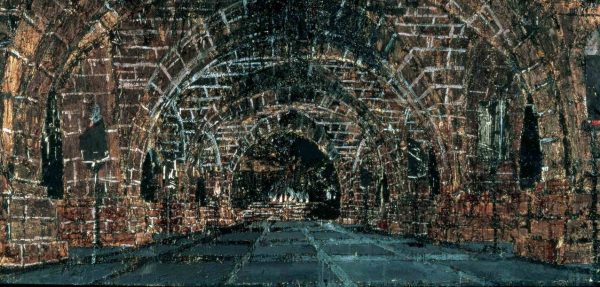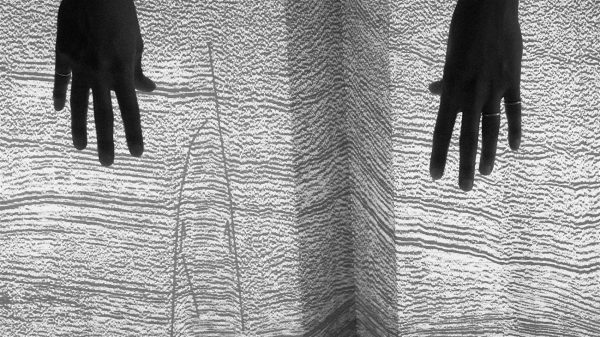Since the Stone Age, people have been concerned with the problem of how to represent life.
Cave paintings at Lascaux show charging bison with multiple legs that appear to gallop in flickering firelight. Protruding lumps of rock add three-dimensionality to animal forms. The overlapping ‘Crossed Bison’ demonstrate an understanding of perspective. Perhaps even more amazingly, archaeologists now believe they have discovered Paleolithic thaumatropes — bone discs with cleverly matched illustrations on either side that can be spun on threads of animal tendon to give the illusion of movement. While all lifeforms, including plants, put a great deal of energy and ingenuity into avoiding death, humans are unique in our endless fascination with the production of ‘lifelike’ images. From galloping charcoal stags to leaping bronze satyrs, through Renaissance chiaroscuro right up to digital 3D, we appear to have an unquenchable thirst for artificial portrayals of aliveness, and to value very highly the labours and inventiveness of those who are able to capture it convincingly. While the numerous artistic revolutions of the twentieth century might have thrown this persistent human passion into question, it clearly isn’t a craving we are simply free to drop.
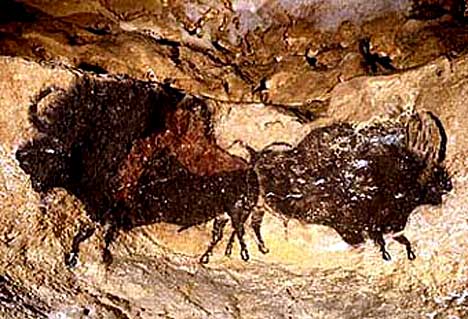
Ron Mueck makes ‘realistic’ sculptures. At first this may seem to refer to the fact that his naturalistically-proportioned figures are awash with signs of both life and mortality: wrinkles, liver spots, excess fat, mottled skin and brushable hair. But it’s clear on looking at Mueck’s work that it’s neither the acutely observed surface phenomena, nor the impeccably formed underlying mass, that make his sculptures so persuasively lifelike. As he says, ‘I’m just trying to make them ordinary. I don’t want people to see the wrinkles, just the person.’ Rather than being wowed by his extraordinary technique, we might instead forget all about it in favour of imagining the thoughts and feelings of the figure being depicted. In opposition to the modernist passion for truth to materials, Mueck invites us to forget that these objects are made of fibreglass and silicon and, instead, to invest them with life. In doing this, he also sidesteps postmodernism — by taking human subjectivity seriously. All his attention to surface detail is at the service of something else. But how might it be possible to think about what this ‘something else’ is?
In 1970 the Japanese roboticist Masahiro Mori coined the term ‘the uncanny valley’ to describe a sharp fall in people’s fondness for robots at the very moment they suddenly appeared too humanoid. The ‘valley’ refers to the dip in the graph that charts people’s positive feelings towards artificial beings. As long as a robot didn’t try too hard to look like a person, any clever tricks it performed would generally be deemed charming and impressive. But as soon as it started to move, speak and look like a human being, people were liable to find it spooky, possibly even disgusting. However, on the other side of the ‘valley’ Mori’s graph began to rise again. As robots became truly lifelike, apparently, people would start to warm up to them once more. So the ‘uncanny valley’ refers to a disturbing zone of unconvincingness. The figure is at once too lifelike and not lifelike enough — it lacks the ‘something else’. The horror and disgust it evokes echoes our typical response to a corpse. (Now makers of expensive computer animated films fret over these hard-to-define tipping points as they threaten to make every difference as to whether or not they will make their money back at the box office.)
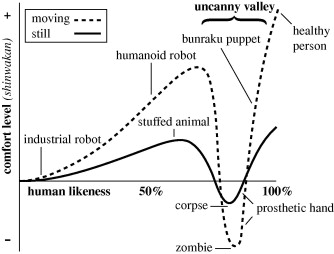
Mori’s use of the word ‘uncanny’ echoes Freud’s study of the term half a century earlier. Freud argued that a sense of uncanniness could be triggered by the re-emergence of a primitive or infantile mode of thought. For example, while we might think we are sophisticated people who know that the dead don’t come back to life, it may still be difficult to fully accept the reality of dying. If anything tempts us to throw it into question — a figure in the distance who looks like our long-deceased brother, perhaps — we might suddenly find ourselves inclined to believe in ghosts.
Likenesses and doubles were thought to lend themselves particularly to uncanny effects because of their association with the wish to cheat mortality. An Ancient Egyptian king might hope that his durable, open-eyed funeral casket would save him from oblivion but, as with creepy ancestral portraits, it may instead become a sinister emblem of non-being and decay. Similarly, a person who has tried to ward off the encroaching signs of ageing with extensive plastic surgery might appear extremely frightening to the young, and to those of us who don’t hold faith in the idea that incisions and injections will make us plausible doubles of our former selves.
It seems that our particular brand of death awareness — we can conceptualise, depict and prepare for death in ways that other creatures can’t, even if, at some level, we still don’t quite believe in it — also sensitises us to the extraordinary anomaly that is life. Life is perhaps so unthinkable to us that we have to keep checking up on it, seeing what we can say about it, do about it, what it looks like. Most of the time we’re not even aware we’re at it — we’re just watching films, meeting friends, reading newspapers and staring out of the window. But as we look and interpret, we are honing the expertise we’ve been developing since birth, becoming greater and greater connoisseurs of the outward signs of existence. You’d never get a dodgy robot — not to mention a minor nose job — past us. We are so good at reading surfaces that we can even tell when people are just very slightly fibbing.
For centuries, an art training meant a solid grounding in aping the appearance of life. A master could teach you all about plumb lines, foreshortening and shading so that you would supposedly finish up able to make a recognisable person, place or object appear at will. This, of course, could only ever be part of the game — some people were much better at it than others. (And then cameras came along and made ‘accuracy’ a far less valuable commodity.) Artists who were able to do more than simply trace the shapes of things have, throughout history, been seen as extraordinary individuals. This is surely no less true today than it was in the days of Caravaggio or Rembrandt.

People have wondered what kinds of singular inner workings might lead a person to be able to perform this most mysterious form of magic; to make life — the one thing even more mind-bending than death — appear to spring up where it isn’t. Which brings us back to Ron Mueck…
Ron Mueck can do something odd, something that Paleolithic people were also hard at work on; he is brilliant at conjuring a semblance of life out of dead matter. Even his sculptures of dead things (‘Dead Dad’, 1996-7, ‘Still Life’, 2005) have a tangible sense of life having recently departed. Because this is such an unusual and highly esteemed quality, he is liable to become an object of fascination in his own right. People may very well want to know how he came to possess this most cherished skill. (Sometimes they even doubt it, believing the work must be made mechanically using casts and computerized scaling — how could a mere human make something so extraordinary?) It’s well known that Mueck didn’t go to art school, but grew up helping his parents make dolls for their family business. He noticed that the toys his family made were more lifelike than the ones he saw in his friends’ houses. As a teenager his parents trusted him to make finishing touches, like adding stubble to dolls that had already been worked on for twenty hours — he couldn’t afford to be bad at it. Making things, and taking it seriously, seems to have been so much a part of his life that he’s perplexed by the idea that other people can’t, or don’t do it. But not everyone grows up in a family with such an intense interest in portraying liveliness. Anyone nosy, or psychoanalytically minded, might very well wonder what sorts of fantasies and/or losses would lead to a driving fascination of this sort, but Ron Mueck isn’t the person to ask about it. Nobody can explain precisely why or how he does what he does, not least Mueck himself (who visibly squirms if anyone tries to make him).
Each of Mueck’s new sculptures depicts a relationship: there’s a giant elderly couple in swimsuits, the man reclining on the woman’s lap; there’s a half-sized adolescent boy and girl in casual sportswear, seemingly sweetly head-to-head, until you discover that the boy is gripping the girl’s wrist tightly behind her back; there’s a scaled down mother and baby, the baby nestled inside the mother’s coat, its head sticking out of her collar. All of the works take as their starting point a moment spotted in passing — something that happened, unannounced, in public and caught Mueck’s interest. In these works it’s not just the individuals we might wonder about, but whatever is going on between them. The ‘something else’ here goes beyond the interiority of a single being and extends into the invisible forces that link people together. What you see will depend a great deal on your own inclinations. How do the elderly couple feel about each other? Is this an image of blissful mutual acceptance? Or are they bored and frustrated, the man slyly peering out at younger, more conventionally beautiful women as he flops against his wife’s saggy thigh? What’s happening between the boy and the girl? Is he bullying and controlling her? Or could he be saving her from throwing herself under a train? The fact that the works pose such unanswerable questions must surely be part of what makes them come alive — we aren’t just looking impassively at a thing, but the thing is interrogating us, causing us to wonder about other people, relationships, ourselves. No amount of plumb lines, anatomy classes nor perfectly pigmented blemishes can produce this effect. It comes from somewhere else.
The multiple maquettes for the mother and baby show a number of possibilities. In one, the baby’s face points outwards. In another the mother looks off to the side. Mueck settled on an inward-facing baby and forward-looking mother for the final work because, in his words, ‘At least that way the baby has a hope.’ But a hope of what exactly? Of seeing and being seen by its mother? Of a response? Of recognition? Although the mother stares out over the baby’s head as she lugs her shopping along, there seems a chance that she might look down at some point. The pair are missing one another — in spite of being literally tied together — but perhaps not indefinitely.
By seeing and being seen, recognising and being recognised, addressing and being addressed, babies become socialised beings. The things that come back from a mother couldn’t come back from a robot. While our psyches may be constructed from complex networks of signifiers, they are always signifiers that are problematised by something else. Becoming a person involves an interrelation; it can’t be done alone. We absorb the troubled, haunted signifiers of the Other. It’s a flawed and faulty process — mothers don’t always do what babies want, and vice versa — but the glitches are as important as the bits that go well. Babies learn by looking and interpreting, sending out signals — cries, smiles — and trying to piece together an understanding about the world from whatever comes back. They speculate in order to develop. Looking at other people, and imagining what goes on inside them, is an enormous part of how we become ourselves. It’s a painful, pleasurable, exasperating, fascinating process that begins at birth and, if we are curious and generous, continues until we die. Artists who can show us something about that process, who are sensitive to what it means to love, suffer, worry and be misunderstood, do us a huge favour. They accompany us and help us to keep looking in a lively way — not only at exteriors, but at the infinitely captivating forces that underlie and animate them. Ron Mueck is surely among the best of these artists because he appears to understand so well how invisible things look. And if we feel that other people can see them too it makes life far less lonely.
Ron Mueck presents a major exhibition of new sculpture at the Fondation Cartier pour l’art contemporain, Paris, from 16 April to 29 September 2013
